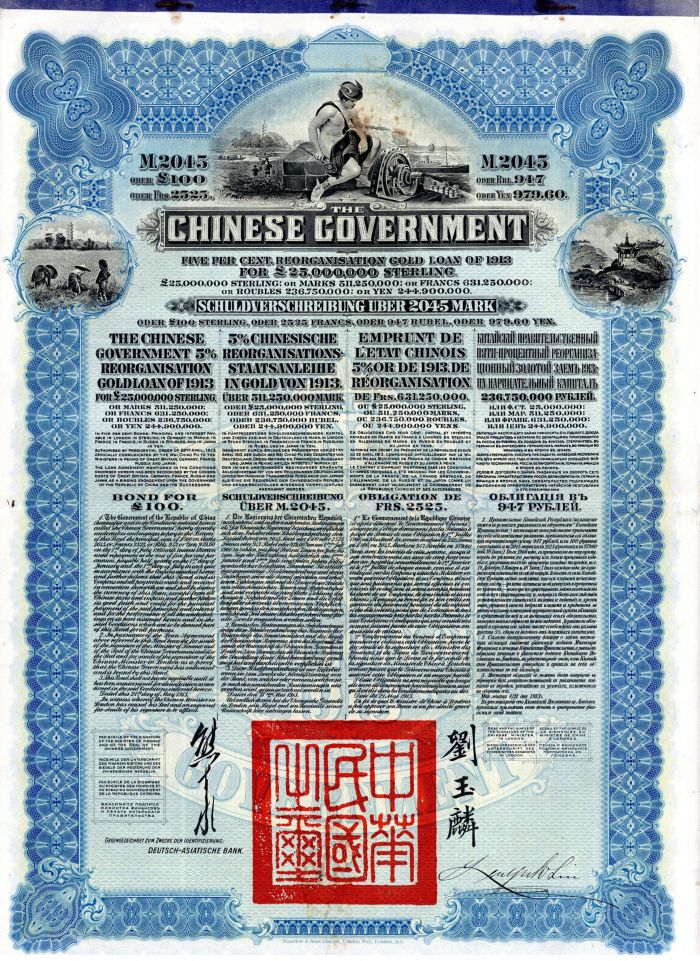Chinese Reorganization Gold Loan Specimen £100 Bond of 1913 - Specimen Bond
Inv# SE3248 Specimen Bond
Chinese Specimen Bond printed by Waterloo & Sons Limited, London, E.C. Full set of coupons.
In 1912, after over two thousand years of imperial rule, a republic was established to replace the monarchy. The Qing dynasty that preceded the republic had experienced instability throughout the 19th century and suffered from both internal rebellion and foreign imperialism. A program of institutional reform proved too little and too late. Only the lack of an alternative regime prolonged the monarchy's existence until 1912.
The Chinese Republic grew out of the Wuchang Uprising against the Qing government, on 10 October 1911, which is now celebrated annually as the ROC's national day, also known as "Double Ten Day". Sun Yat-sen had been actively promoting revolution from his bases in exile. He now returned and on 29 December 1911, Sun Yat-sen was elected president by the Nanjing assembly, which consisted of representatives from seventeen provinces. On 1 January 1912, he was officially inaugurated and pledged "to overthrow the despotic government led by the Manchu, consolidate the Republic of China and plan for the welfare of the people". Sun's new government lacked military strength. As a compromise, he negotiated with Yuan Shikai the commander of the Beiyang Army, promising Yuan the presidency of the republic if he were to remove the Qing emperor by force. Yuan agreed to the deal, and the last emperor of the Qing Dynasty, Puyi, was forced to abdicate in 1912. Song Jiaoren led the Kuomintang Party to electoral victories by fashioning his party's program to appeal to the gentry, landowners, and merchants. Song was assassinated on 20 March 1913, at the behest of Yuan Shikai.
Yuan was elected president of the ROC in 1913. He ruled by military power and ignored the republican institutions established by his predecessor, threatening to execute Senate members who disagreed with his decisions. He soon dissolved the ruling Kuomintang (KMT) party, banned "secret organizations" (which implicitly included the KMT), and ignored the provisional constitution. An attempt at a democratic election in 1912 ended with the assassination of the elected candidate by a man recruited by Yuan. Ultimately, Yuan declared himself Emperor of China in 1915. The new ruler of China tried to increase centralization by abolishing the provincial system; however, this move angered the gentry along with the provincial governors, who were usually military men. Many provinces declared independence and became warlord states. Increasingly unpopular and deserted by his supporters, Yuan abdicated in 1916 and died of natural causes shortly thereafter. China then declined into a period of warlordism. Sun, having been forced into exile, returned to Guangdong in the south in 1917 and 1922, with the help of warlords, and set up successive rival governments to the Beiyang government in Beijing, having re-established the KMT in October 1919. Sun's dream was to unify China by launching an expedition against the north. However, he lacked the military support and funding to turn it into a reality.
Meanwhile, the Beiyang government struggled to hold onto power, and an open and wide-ranging debate evolved regarding how China should confront the West. In 1919, a student protest against the government's weak response to the Treaty of Versailles, considered unfair by Chinese intellectuals, led to the May Fourth movement, whose demonstrations were against the danger of spreading Western influence replacing Chinese culture. It was in this intellectual climate that the influence of Marxism spread and became popular, leading to the founding of the CCP in 1921.
Stock and Bond Specimens are made and usually retained by a printer as a record of the contract with a client, generally with manuscript contract notes such as the quantity printed. Specimens are sometimes produced for use by the printing company's sales team as examples of the firms products. These are usually marked "Specimen" and have no serial numbers.









Ebay ID: labarre_galleries